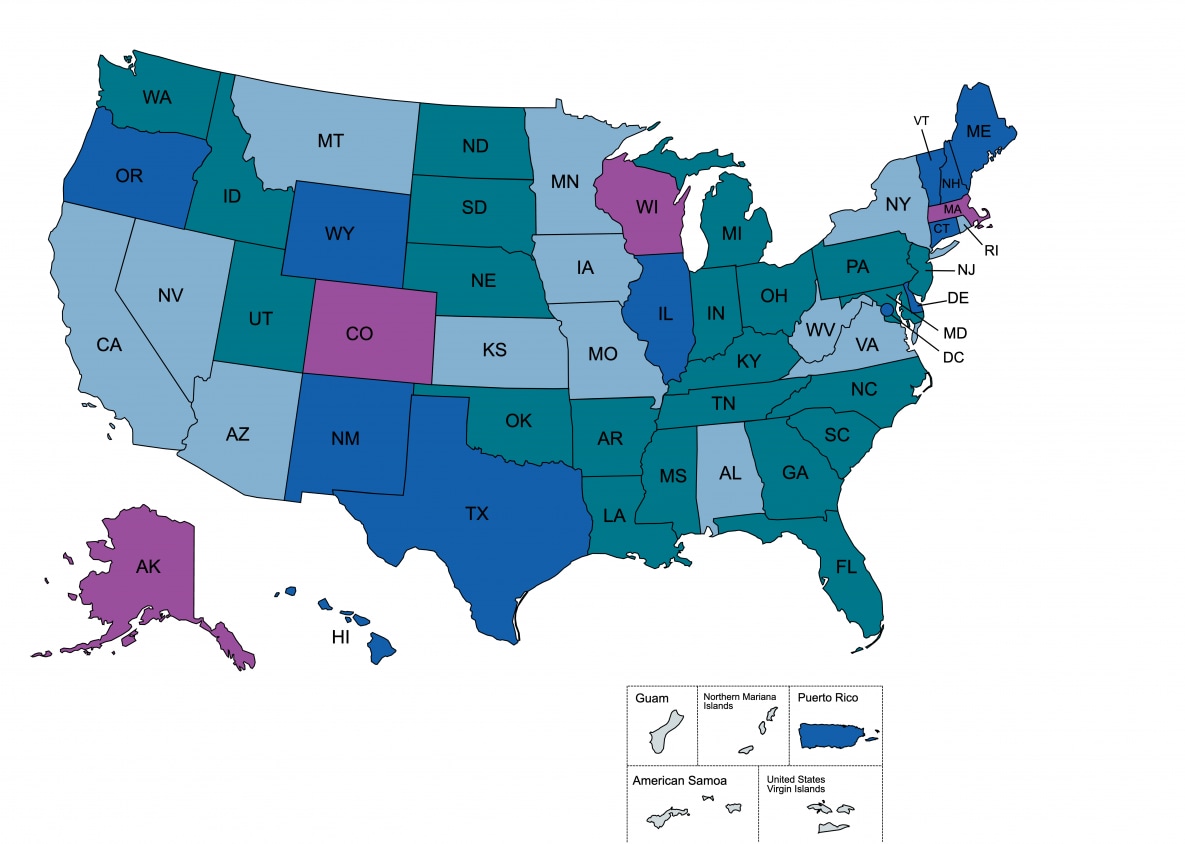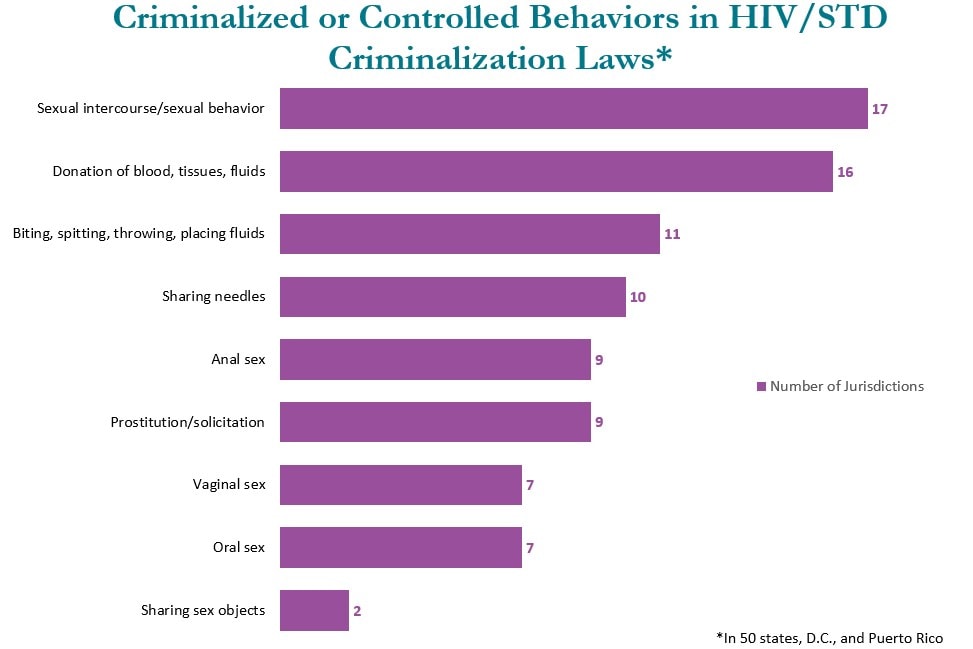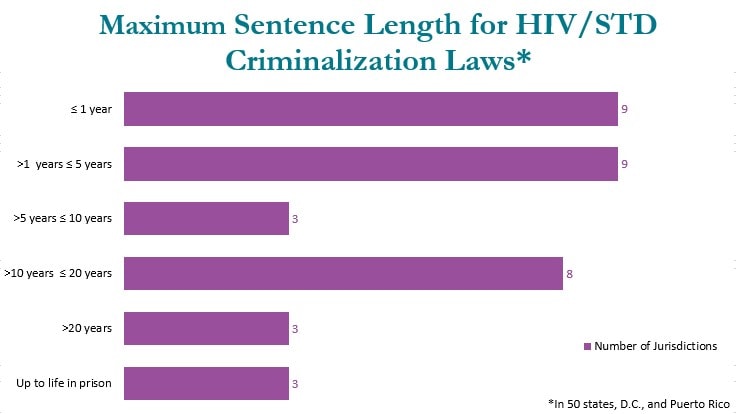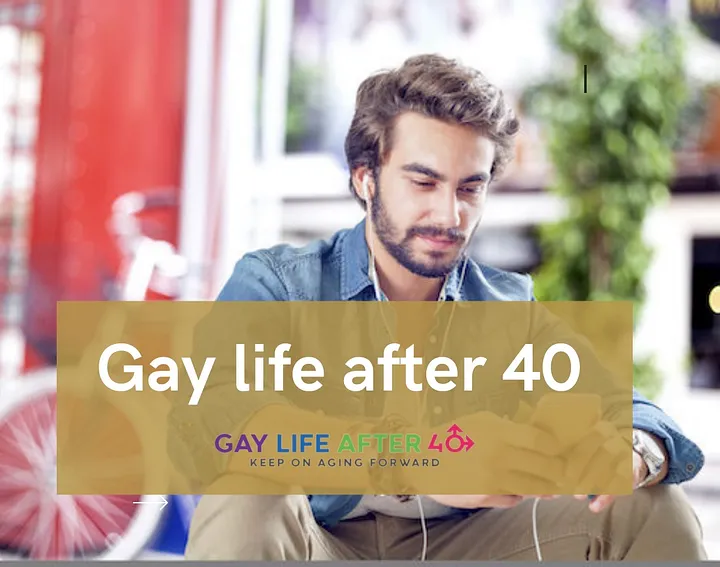
HIV and STD Criminalization Laws
From the Center of Disease Control
www.cdc.gov
As of 2021, 35 states have laws that criminalize HIV exposure.
The laws for the 50 states, the District of Columbia, and Puerto Rico were assessed and categorized into four categories.
- HIV-specific laws that criminalize or control behaviors that can potentially expose another person to HIV.
- Sexually transmitted disease (STD), communicable, contagious, infectious disease (STD/communicable/infectious disease) laws that criminalize or control behaviors that can potentially expose another person to STDs/communicable/infectious disease. This might include HIV.
- Sentence enhancement laws specific to HIV, or STD that do not criminalize a behavior but increase the sentence length when a person with HIV commits certain crimes.
- No specific criminalization laws.
General criminal statutes, such as reckless endangerment and attempted murder, can be used to criminalize behaviors that can potentially expose another to HIV and or an STD. Many states have laws that fall into more than one of the categories listed above. For this analysis, only HIV-specific laws are captured for states with both HIV-specific laws and STD/communicable/infectious disease laws. Only HIV or STD/communicable/infectious disease laws are captured for states with both HIV or STD/communicable/infectious disease laws and sentence enhancement statutes.
During the early years of the HIV epidemic, many states implemented HIV-specific criminal exposure laws to discourage behavior that might lead to transmission, promote safer sex practices, and, in some cases, receive funds to support HIV prevention activities. These laws were passed at a time when very little was known about HIV including how HIV was transmitted and how best to treat the virus. Many of these state laws criminalize behaviors that cannot transmit HIV – such as biting or spitting – and apply regardless of actual transmission, or intent. After over 30 years of HIV research and significant biomedical advancements to treat and prevent HIV transmission, many state laws are now outdated and do not reflect our current understanding of HIV. In many cases, this same standard is not applied to other treatable diseases. Further, these laws have been shown to increase stigma, exacerbate disparities, and may discourage HIV testing.
HIV and STD Criminalization Laws 2021


Criminalize or Control Behaviors Through HIV-Specific Statutes and Regulations (n=22)

Criminalize or Control Behaviors Through STD/Communicable/Infectious Diseases Specific Statutes (n=13)

Sentence Enhancement Statutes (n=4)

None/General Criminal Statutes (n=13)
Criminalization of potential HIV exposure is largely a matter of state law, with some Federal legislation addressing criminalization in discrete areas, such as blood donation and prostitution. These laws vary as to what behaviors are criminalized or what behaviors result in additional penalties. Several states criminalize one or more behaviors that pose a low or negligible risk for HIV transmission.

In 12 states, laws require people with HIV who are aware of their status to disclose their status to sex partners, and 4 states require disclosure to needle-sharing partners.
The maximum sentence length for violating an HIV-specific statute is also a matter of state law. Some states have a maximum sentence length up to life in prison, while others have maximum sentence lengths that are less than 10 years. However, only 9 states have laws that account for HIV prevention measures that reduce transmission risk, such as condom use, and antiretroviral therapy (ART).

Since 2014, at least nine states have modernized or repealed their HIV criminal laws: California, Colorado, Illinois, Iowa, Michigan, Missouri, Nevada, North Carolina, and Virginia. Changes include removing HIV prevention issues from the criminal code and including them under disease control regulations, requiring intent to transmit, actual HIV transmission, or providing defenses for taking measures to prevent transmission such as viral suppression or being noninfectious, condom use, and partner PrEP use.
Resources
Background on HIV Criminalization in U.S.
The following resources provide a broad overview of HIV criminalization in the United States. Specifically, these resources address the science of HIV, provide background literature on the history and practices of HIV criminalization, and the current status of HIV criminalization laws and statutes in the United States.
- The Center for HIV Law and Policy: HIV Criminalization in the United Statesexternal icon
- The Center for HIV Law and Policy: Criminal Law web page and resource bankexternal icon
- The Center for HIV Law and Policy: The Science of HIV for Lawyers and Advocatespdf iconexternal icon
Case Studies
The following case studies provide an in-depth analysis of the HIV criminalization laws, practices, convictions, and sentencing outcomes in a variety of states.
- The Williams Institute: State Case Studies
- HIV Criminalization in Florida: Length of Incarceration and Fiscal Implications | July 2021 | Floridaexternal icon
- HIV Criminalization in Georgia: Length of Incarceration and Fiscal Implications | June 2021 | Georgiaexternal icon
- Enforcement of HIV Criminalization in Nevada | May 2021 | Nevadaexternal icon
- HIV Criminalization in California: Evaluation of Transmission Risk | December 2016 | Californiapdf iconexternal icon
- HIV Criminalization in Florida Evaluation of Transmission Risk | February 2020 | Floridapdf iconexternal icon
- HIV Criminalization in Georgia | January 2018 | Georgiaexternal icon
- The Criminalization of HIV and Hepatitis B and C in Missouri, An Analysis of Enforcement Data from 1990 to 2019 | February 2020 | Missouripdf iconexternal icon
Federal Guidance
The current federal guidance from the U.S. Department of Justice on HIV criminalization practices and reform is provided below.
- Department of Justice: Best Practices Guide to Reform HIV Specific Criminal Laws to Align with Scientifically Supported Factorspdf iconexternal icon
Scientific and Legal Research
The following resources represent a sample of articles from the legal and scientific research communities.
- Mermin J., Salvant Valentine S., McCray E. (2021). HIV Criminalization laws and ending the US HIV epidemic. TheLancet,8(1), E4-E6. Retrieved from https://doi.org/10.1016/S2352-3018(20)30333-7external icon.
- Baugherm A. R., Whiteman A., Jeffries W. L., Finlayson T., Lewis R., Wejnert C. (2017). Black men who have sex with men living in states with HIV Criminalization laws report high stigma. AIDS,35(10), 1637-1645. Retrieved from https://pubmed.ncbi.nlm.nih.gov/34270489/external icon.
- Sweeney P., Gray S., Purcell D., Sewell J., Babu A., Tarver B., Mermin J. (2017). Association of HIV diagnosis rates and laws criminalizing HIV exposure in the United States. AIDS,31(10), 1483-1488. Retrieved from https://www.ncbi.nlm.nih.gov/pubmed/28398957external icon.
- Lehman J. S., Carr M. H., Nichol A. J., Ruisanchez A., Knight D. W., Langford A. E., Mermin J. H. (2014). Prevalence and public health implications of state laws that criminalize potential HIV exposure in the United States. AIDS and behavior, 18(6), 997–1006. Retrieved from https://www.ncbi.nlm.nih.gov/pmc/articles/PMC4019819/external icon
- Barré-Sinoussi F., Abdool Karim S. S., Albert J., Bekker L. G., Beyrer C., Cahn P., Godfrey-Faussett P. (2018). Expert consensus statement on the science of HIV in the context of criminal law. Journal of the International AIDS Society, 21(7), Retrieved from https://www.ncbi.nlm.nih.gov/pubmed/30044059external icon
- Harsono Dini. Bibliography on criminalization of HIV non-disclosure, exposure, and transmission. New Haven, CT: Center for Interdisciplinary Research on AIDS at Yale University; 2018. Retrieved from https://cira.yale.edu/sites/default/files/Criminalization%20of%20HIV%20Bibliography%20Aug%202018.pdfpdf iconexternal icon

